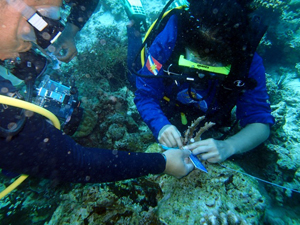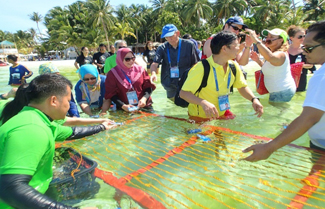 The Philippines’ coral reefs is the largest in Southeast Asia, with 915 reef fish species and more than 400 scleractinian coral species, 12 of which are endemic. It is part of the coral triangle and according to the Australian non-profit company UNICO Conservation Foundation, it has more species of fish and corals than any other marine environment on earth.
The Philippines’ coral reefs is the largest in Southeast Asia, with 915 reef fish species and more than 400 scleractinian coral species, 12 of which are endemic. It is part of the coral triangle and according to the Australian non-profit company UNICO Conservation Foundation, it has more species of fish and corals than any other marine environment on earth.
However, destructive fishing has degraded coral reefs. These include the “muro-ami” fishing technique, which involves pounding on reefs to drive fishes to the incoming net of the fisher. Other destructive practices include coastal development, agriculture, aquaculture, and lack of treatment for industrial waters that threaten the reefs of the country. With the World Resources Institute predicting that in 2030, over 90 percent of coral reefs will be threatened, taking action locally is now more important than ever.
As a response to the coral degradation in the country, the Department of Science and Technology (DOST) and the Philippine Council for Agriculture, Aquatic and Natural Resources Research and Development of the DOST (DOST-PCAARRD) funded the Filipinnovation on Coral Reef Restoration Program that started in 2012.
Having started in 2012, the program seeks to roll out coral transplantation technology using asexually reproduced corals to improve productivity of coral resources for sustainable fisheries.
Corals asexual reproduction technology for reef restoration involves the collection of dislodged live coral fragments or “corals of opportunity” (COPs) and attaching them to coral nursery unit (CNUs) for quick recovery and regeneration to increase survival rates upon transplantation in degraded coral reef sites. Each CNU is designed to hold 500 COPs per batch and can be used several times a year.
The CNU design and the coral transplantation technique which uses marine epoxy clay, nails, and cable tie are outputs of the DOST-PCAARRD funded Filipinnovation program.
Bohol, Pangasinan, Sarangani, Bataan, Zambales, Palawan, Camiguin, Zamboanga del Norte, and Ilocos Norte were identified as restoration sites based on their suitability for restoration; availability of sufficient amount of coral fragments for transplanting, and their location within the marine protected area.
The program has established a total of 538 CNUs and transplanted 487,158 coral fragments. These activities contribute directly to the protection of coastal communities by providing natural barriers, improvement of our marine ecosystem services, development of fishery resources, and enhancement of the underwater tourism industry.
When the Filipinnovation program was completed in 2013, the National Coral Reef Rehabilitation Roll-Out Program continued the work using the same asexual reproduction technology that is now ongoing in nine sites across the country: Pagudpud, Ilocos Norte; Alaminos, Pangasinan; Bagac, Bataan; Subic Bay, Zambales; Puerto Princesa, Palawan; Anda, Bohol; Camiguin, Zamboanga City; and Kiamba, Sarangani. Overall, the two programs are now in 20 locations across 11 regions (1, 2, 3, 4A, 4B, 5, 6, 7, 9, 10, and ARMM).
The direct coral transplantation technique was developed and implemented by the University of the Philippines – Marine Science Institute (UP-MSI) with the local communities to restore an area in Bolinao, Pangasinan. The technique has been pilot-tested in major tourism and diving sites including Batangas, Bohol, and Boracay.
 Boracay coral rehabilitation in the APEC-PPSTI-5
Boracay coral rehabilitation in the APEC-PPSTI-5
The fifth Asia-Pacific Economic Cooperation (APEC) Policy Partnership on Science, Technology and Innovation (PPSTI-5) culminated in Boracay. The event was highlighted with the tying of coral fragments or COPs to the CNUs. Joining the event, the municipal government of Boracay, Malay in the Province of Aklan, which declared a part of its municipal water as the APEC-PPSTI coral garden.
After a month, the team from DOST, Sangkalikasan, and the PCG took photos and videos of the APEC-PPSTI coral garden to document the survival of the transplanted COPs representing the member-economies. While there is no dramatic increase in the growth between the period they had been harvested from the coral nursery, the fully settled and erected fragments indicate that they have strong chance of survival despite the presence of algae and a few sediments in the tags and coral substrates. Over time, the rehabilitated reefs will be re-inhabited by fish aquatic life. The restoration of reefs has other major positive economic impacts. It improves the productivity and sustainability of municipal fisheries and at the same time enhances the beauty and value of the area for the underwater tourism industry.
Other restoration activities
Aside from the APEC-PPSTI coral reef restoration in Boracay, DOST-PCAARRD also funded the restoration of the Bakud reef, located in the town of Kiamba, Sarangani. The Provincial Government of Sarangani collaborated with the Mindanao State University-General Santos City, which was the project implementer. The project is also part of the Filipinnovation program.
The restoration effort became necessary when MV Double Prosperity, a Panamanian-registered vessel, ran aground Bakud Reef destroying massively some 2,844 square meters of precious coral reefs, among other major damages.
The project is expected to transplant 30,000 coral fragments to restore damage reef area; set-up and deploy 10 CNUs; identify, document and establish a stream of dive sites; and develop a pool of human resources for coral restoration and eco-tourism.
Also part of the Filipinnovation program is the coral reef restoration project at the tourist spot, Hundred Islands in Alaminos, Pangasinan. The project is supported by the Pangasinan State University (PSU), LGU of Alaminos, Pangasinan, the Citizens' Armed Force Geographical Units (CAFGU) of the Philippine Army Auxillary Force, and the RVS 4 Star Mariculture Coral Farm (RVS4Star).
Quezon Island was identified as the donor/collection site; Clave Island for setting up of the CNUs, and Romulo Island as the transplantation site.
Meanwhile, Bagac, Bataan, and Subic, Zambales were also named as beneficiaries of the coral transplantation technology. Bataan Peninsula State University (BPSU) and Sangkalikasan Producer Cooperative served as implementing and collaborating agency, respectively.
DOST-PCAARRD will showcase corals for transplantation including other agri-aqua research and development (R&D) outputs on March 2-4, 2016 during the SIPAG FIESTA at its headquarters in Los Baños, Laguna.
SIPAG, a technology transfer strategy, embodies the Council’s commitment to DOST’s Outcome One in a bid to ensure that the fruits of R&D activities for the agri-aqua sectors will be a blessing for every Juan.
